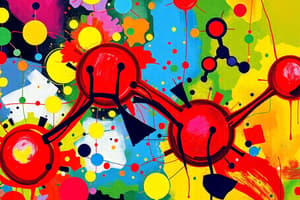Podcast
Questions and Answers
Ionic bonds are formed when a pair of electrons is shared between two atoms.
Ionic bonds are formed when a pair of electrons is shared between two atoms.
False (B)
In a covalent bond, each atom donates one electron to form the bond.
In a covalent bond, each atom donates one electron to form the bond.
True (A)
Coordinate bonds are formed when one atom donates both electrons to the bond.
Coordinate bonds are formed when one atom donates both electrons to the bond.
True (A)
Hydrogen bonds are formed when the partially positive hydrogen of one molecule interacts with the partially positive hydrogen of another molecule.
Hydrogen bonds are formed when the partially positive hydrogen of one molecule interacts with the partially positive hydrogen of another molecule.
Ionic bonds are commonly found in salts.
Ionic bonds are commonly found in salts.
Ionic bonds are formed between molecules or between atoms with the same charges.
Ionic bonds are formed between molecules or between atoms with the same charges.
In a covalent bond, each atom donates one electron to form a two-electron bond.
In a covalent bond, each atom donates one electron to form a two-electron bond.
Coordinate bonds are also known as dative bonds.
Coordinate bonds are also known as dative bonds.
Hydrogen bonds are formed between two hydrogen atoms.
Hydrogen bonds are formed between two hydrogen atoms.
Ionic bonds are present in salts.
Ionic bonds are present in salts.
Flashcards are hidden until you start studying
Study Notes
Ionic Bonds
- Formed between molecules or atoms with opposite charges
- Negatively charged anion electrostatically attracts positively charged cation
- Present in salts
Covalent Bonds
- Formed by sharing a pair of electrons between two atoms
- Each atom donates one electron
- Represented by a single line
Coordinate Bonds
- Formed by sharing a pair of electrons between two atoms
- One atom donates both electrons
- Represented by a single line or an arrow
Hydrogen Bonds
- Formed by interaction between partially positive hydrogen (δ+) and partially negative heteroatom (δ-)
- Heteroatom examples include oxygen or nitrogen
- Occurs between molecules
Ionic Bonds
- Formed between molecules or atoms with opposite charges
- Negatively charged anion electrostatically attracts positively charged cation
- Present in salts
Covalent Bonds
- Formed by sharing a pair of electrons between two atoms
- Each atom donates one electron
- Represented by a single line
Coordinate Bonds
- Formed by sharing a pair of electrons between two atoms
- One atom donates both electrons
- Represented by a single line or an arrow
Hydrogen Bonds
- Formed by interaction between partially positive hydrogen (δ+) and partially negative heteroatom (δ-)
- Heteroatom examples include oxygen or nitrogen
- Occurs between molecules
Studying That Suits You
Use AI to generate personalized quizzes and flashcards to suit your learning preferences.




